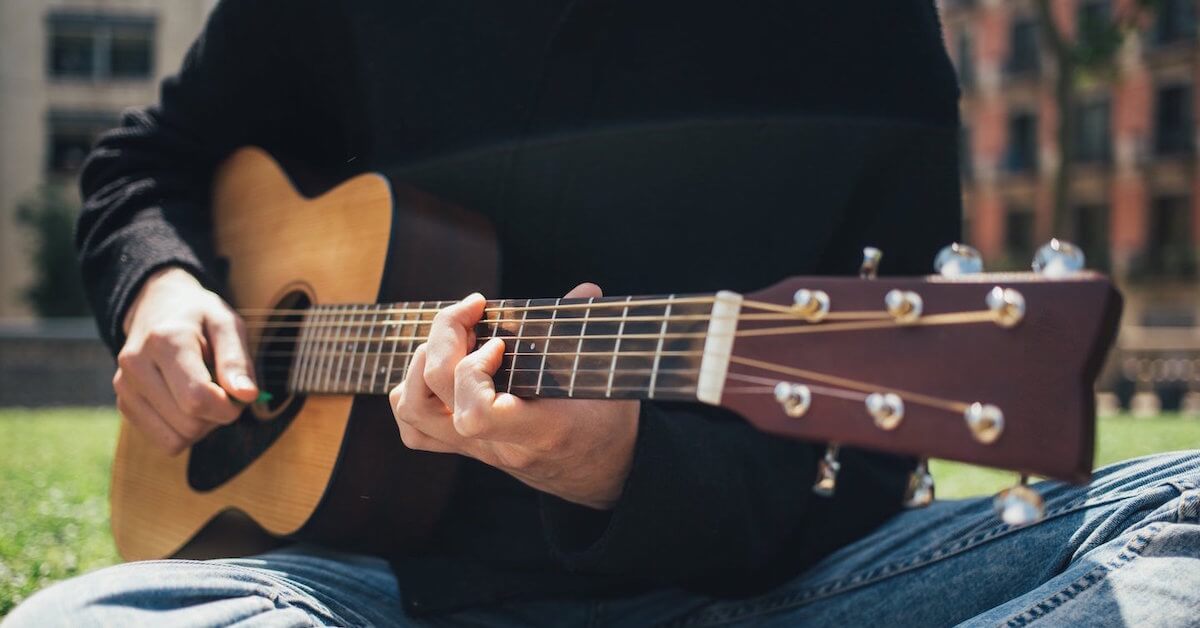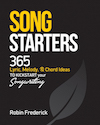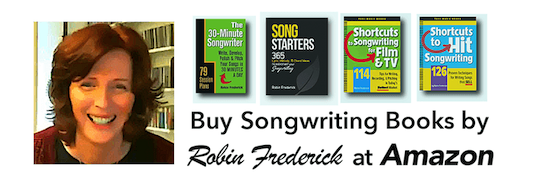
This easy-to-use guide will show you how to write a song, from finding a great title to writing your melody. Hands-on songwriting exercises will jump start your creativity, while ‘how-to’ video tutorials are a fun way to find out more.
by Robin Frederick. Request permission to reprint
What comes first, melody or lyrics? How does an idea become a whole song? How do you know if your song is any good? Well, I’ll answer the first two questions in this article. The third question – How do you know if your song is good? – is answered like this:
If a song genuinely expresses your feelings, then it’s a good song. It doesn’t matter what anyone else thinks.
If a song expresses your feelings AND touches other people, moves them emotionally, or gets them on the dance floor – that’s a good song with the potential to become a HIT.
So, how do you write a song that moves other people and makes them want to listen? Well, that’s where song craft comes in.
‣ What is song craft and why do I need it?
Good songwriters use song craft to give their songs emotional impact and create a memorable experience for listeners. The tools and techniques of our craft are not arbitrary; they weren’t invented just to drive us crazy or make us write copy-cat songs without depth or originality. They exist because, over hundreds of years, songwriters have found that they help listeners to understand, experience, and remember the message at the heart of a song.
The simple, time-tested ideas on this page will help you write a song that expresses your feelings and moves listeners, keeping them involved and interested in what you have to say. Like any skill, though, song craft takes a little practice, so be sure to try the “Go Ahead and Do It” exercises that follow each step.
CONTENTS…
1. | GET STARTED
2. | BUILD YOUR SONG ON A TITLE
3. | TRY A HIT SONG STRUCTURE
4. | ADD IMAGES & RELATED WORDS
5. | CREATE A MELODY
6. | FIND THE CHORDS
7. | FIND A CO-WRITER
8. | DEMO YOUR SONG
‣ How does a song get started? (Good question!)
Getting started can be one of the hardest tasks in songwriting. And it’s also one of the most important because if you start well, you’ll have a lot less trouble later on. You’ll know where you’re going and you’ll have plenty of things to say.
There’s always the temptation to jump right in and begin with the first thing that occurs to you. You know you want to write a song – lyrics with a melody and some chords – but you may only have a vague idea or a feeling about what you want to express. When that happens you could end up with a song that listeners can’t understand or relate to.
So which comes first – lyrics, melody, or chords? My answer is: None of the above. There are a lot of ways to start a song and you could start with one of those, but I’m going to suggest that you start with THE TITLE.
The title is going to be the line that everyone remembers. More important, it’s going to define the message of the song. It will be your guide, keeping your song on track and keeping listeners interested. Think of your title as the peak of a pyramid. The rest of the song is made up of the building blocks that support it.
Start your song with a title that appeals to you. Make sure it’s a phrase that rings true in your ears. Something that makes you say, “I’ve got to know more about that!” Because if YOU want to know, others will want to know.
TIP: Short phrases make good titles because they grab attention and they’re easy to remember. The ideal length for a title is one to five words.
Where to find good titles
Keep your eyes and ears open for good titles that have energy for you. Action words, images, or short phrases make good titles. Attention-grabbing newspaper headlines are full of good titles. Here are a few examples of titles I picked up by reading through a popular magazine: “A Dream On The Edge,” “Hiding in the Shadows,” “What You Can’t Change,” “Slipping Away.”
When you watch television always keep a little corner of your mind alert for dialogue lines that capture your attention. Listen to your friends and family to see if you can pick out interesting phrases. Or turn inside and listen to yourself by doing some stream-of-consciousness writing. Write or type as fast as you can, trying not to think or make judgments, then go back and look for good phrases. Start keeping a list of these potential titles. You can use them whenever you’re ready to write a song.
GO AHEAD AND WRITE A SONG – Start your title list right now. Pick up a book or magazine, or scan for interesting short phrases. Write down at least three phrases. Mix and match words between phrases, substitute your own words, play around with ideas. Try to come up with at least one phrase that makes you want to write a song. Keep looking for more phrases until you have something you like. Draw a big circle around that phrase. Then keep reading.
Use my book “Song Starters” to find dozens of great titles, phrases, themes, and more! Available at Amazon.com.
‣ Turn a title into a lyric. Here’s how.
Now, let’s begin to turn your title into a great lyric by simply asking a few questions – the questions suggested by your title. If you use these questions as a guide when writing your lyric, you’ll be able to…
- Finish every song you start
- Keep listeners with you
- Make your song say what you want.
Ask the questions hidden in your title
Every title suggests questions that need to be answered. Some of the questions will be ones that you want to explore, others will be questions that listeners have. You’ll need to answer both. Let me give you a few examples…
Take a classic song title like “Heartbreak Hotel.” Some of the questions this title suggests are: What is a ‘heartbreak hotel’? What happens there? Where is it?
Sure enough, these questions are all answered in this great Rock standard.
- What is a ‘heartbreak hotel’? A place to go when your baby leaves you.
- What happens there? Brokenhearted lovers cry.
- Where is it? Down at the end of Lonely Street.
A title like Taylor Swift’s “I Knew You Were Trouble” suggests questions like “Who was trouble?” “What kind of trouble?” and ‘How did things turn out?” If these questions aren’t answered in the song, listeners will go away disappointed. Here’s the lyric. Take a look to see how these questions were answered.
In a big Country hit like “You’re Gonna Miss This” recorded by Trace Adkins, listeners will be asking “What will this person miss?” and “Why will he miss it?” Check out the lyric. You might be surprised by the answer! That’s the sign of a great song. It draws the listener in with questions, then answers them in a fresh way.
Of course, you’ll also have questions you want to write about. Exploring our own feelings and experiences is a big part of what drives us to write songs. So, here are a few questions you might want to answer.
- What does your title mean?
- How do you feel about that?
- Why do you think that happened?
- What do you hope or fear will happen next?
If you’d like to hear a lyric example, listen to “Be With You,” a song I wrote with singer-songwriter Ed Patrick for our duo Neverway. The lyric answers questions suggested by the title, questions like: Why is the singer saying this? What’s happening? Who is involved? What is the singer feeling? Why is it important to him?
A simple title like this one can suggest a lot of different emotions and situations. Ed and I wrote about the feelings we wanted to express, but another songwriter could go in an entirely different direction with the same title. You can choose the questions you want to answer and the way you want to answer them.
GO AHEAD AND WRITE A SONG – Go back and look at the title you circled in the previous exercise. What questions does it suggest to you? What would you like to say about it? Write down the questions you’d like to answer. Then add any questions you think listeners might have.
Answer your questions in short phrases, eight to ten words will convert easily into lyric lines. Write more than you think you’ll need; you won’t use all of it. Remember, it’s just raw material. Explore the possibilities. Don’t worry about rhyming, just say what you want to say. That’s the best place to start.
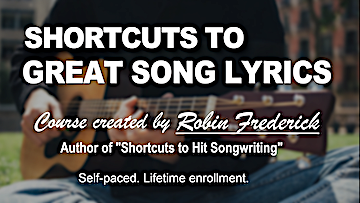
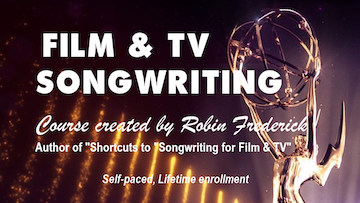
‣ Why is song structure such a big deal?
Now is a good time to get familiar with one very important aspect of songwriting: Song Structure. An easy-to-follow structure acts like a pathway, leading your listener through your song from beginning to end. This is a key point to keep in mind when you write a song.
The most common contemporary hit song structure looks like this:
VERSE / CHORUS / VERSE / CHORUS / BRIDGE / CHORUS.
Listeners like this song form because it provides enough repetition to feel familiar and enough variety to keep them interested. It also gives you, the songwriter, the chance to add emotional dynamics to your song. Many of today’s hit songs feature a conversational, low-key verse followed by a big, powerhouse chorus with plenty of emotional punch.
Once you get familiar with this basic song structure, there are plenty of add-ons and variations to play with. Some songs have a pre-chorus or a post-chorus section with catchy hooks to make sure the listener will remember the song. But try using this structure to get started. It’s been the basis of many huge hits and many more to come.
Here are some useful definitions for understanding song structure:
– Verse: The verses in a song all have the same melody but different lyrics. The verse lyrics give us information about the situation, emotions, or people in the song.
– Chorus: We may hear the chorus of a song three, four or more times. The lyric and melody remain the same each time it recurs.The chorus lyric sums up the heart of the song. The title of the song almost always appears in the chorus section and may be repeated two or more times.
– Bridge: The bridge has a different melody, lyrics, and chord progression from the verse or chorus. It provides a break from the repetition of verse and chorus. The lyric often provides an insight or revealing moment.
GO AHEAD AND WRITE A SONG:
1. Use the song form VERSE / CHORUS / VERSE / CHORUS / BRIDGE / CHORUS.
2. Look at the questions you wrote down in the previous section and choose a question to answer in each section of your song. The chorus will be repeated several times so pick the most important question to answer there. Often, that question is “How does that make me feel?”
3. Be sure to use your title in your chorus! Fill in a few lines around your title answering some of the questions you think listeners might have. Make sure your listeners understand your song by having the singer come right out and say what he or she really feels at least once in the chorus.
4. When you have a rough idea of your chorus lyric, move on to a verse. Verse lyrics tend to be more conversational, so keep it simple and just answer the question you picked for each verse in an open, honest way.
‣ Add images & related words to bring your song to life
Just like a potter has clay and a painter has tubes of paint, the songwriter has images, action words, and fresh ideas. When you write a song, these are your raw materials. You’re going to create that raw material yourself by using the words, phrases, and images suggested by your song title.
Make a list of words and images the title suggests
Let’s say your song title is “You Make Me Smile.” To create raw material based on this title, think of words and images associated with smiling. We can start with obvious ones like “happy,” “sunny,” “bright,” and “fun.” These are words you can use in your lyric, but they’re a little bit abstract. Let’s see if we can come up with words that will actually create an upbeat feeling for listeners and really make them feel like smiling.
Take the words “happy” and “fun,” for instance. What are a few things that are fun, things that make people smile? Parties, dancing, weekends, and vacations. The sound of laughter and music. Favorite foods and a day at the park with friends. A trip to the beach, a night on the town. Bright lights and crowds and carnival rides.
These are just rough ideas. Try not to judge whether they’re good or not at this stage. Just write down everything that comes to you. You won’t use all of it, but you never know what might end up in your song.
Now, let’s try the word “sunny.” Obviously that word makes me think of sunshine, which makes me think of summer and being outdoors, which makes me think of grass, trees, and flowers. Flowers make me think of colors – gold, red, purple – and bees buzzing around.
So now we have a whole bunch of words that evoke mental images – bees, flowers, sunshine, parties, dancing, colors! They all have to do with smiling and feeling good. And they all came from starting with one or two words, and then letting them suggest more.
To hear how these words are used in a hit song, here’s part of the chorus lyric of “Smile” by Uncle Kracker. Notice how many words are similar to the ones we came up with.
You make me dance like a fool
Forget how to breathe
Shine like gold
Buzz like a bee
Just the thought of you can drive me wild
Oh, you make me smile
Now the listener is able to picture how the singer is feeling instead of just having to take her word for it. This is one of the most important tools a songwriter has. Check out “Smile” by Uncle Kracker on Spotify, read the lyrics online, or watch the video to hear even more fun images and ideas based on smiling.
BONUS TIP: After you have a list of related words, make a list of contrasting words and images, ones that suggest the opposite. For example, I wrote a song called “California Girl.” Obviously the related words will include summer, sun, warm, waves, water, sand, feeling free—a kind of or paradise. Contrasting words might be winter, moon, cold, fire (contrasting with water), and feeling caught or trapped (the opposite of feeling free).
If you’d like to hear how I turned these lists of related and contrasting words into a lyric, watch the video of my song “California Girl.”
GO AHEAD AND WRITE A SONG – Make a list of words, images, and phrases related to your title. Write down single words or short phrases. Don’t think about rhyming or making sense of things at this point. And try not to be critical of your ideas – just write down what comes to you. Then, make a list of contrasting words, images, and phrases. Write as many words as you can think of in each column. Let one idea suggest another and follow the trail wherever it takes you. This is a great exercise for stretching your creativity.
When you have a good list of words, try plugging some of them into your verse and chorus lyrics. Replace a statement with an image or action that helps to express the emotion in your song and makes the listener feel what you feel or see what you see.
‣ Look for the melody that lives in your lyrics
Every time you open your mouth to speak, you start singing! Don’t believe me? Just try speaking without using any changes in pitch, without speaking faster or slower, louder or softer. You can’t do it! You end up sounding like a robot. Although we usually think of singing as something quite different from talking, we actually use a lot of melody when we talk.
When we talk we use pitch, volume, phrasing, and rhythm – all the elements of a song melody. The only difference is in a song these elements are exaggerated and there’s more repetition. So if you have a few lyric lines, all you need to do is speak them to get a raw melody started.
Melody, speech, and emotion
It’s the melody part of speech that communicates emotion. In fact, just by changing the melody you can give the same words an entirely different emotional meaning. Try this: say the phrase “Oh, no?” as if you are asking a simple question. Now, say the same phrase — “Oh no!” — as if you are anxious and frightened. Notice the difference in the melody? In the question, the melody goes up at the end. In the frightened version, the pitch starts higher and then the melody moves downward. Exaggerate the emotion in the second phrase and you’ll really hear it. Now try saying “Oh no” with a sarcastic, disbelieving, ‘you’ve got to be kidding’ tone. It’s an entirely different melody from the other two.
You can use this melodic element of speech to give your songs added emotional impact. If you’ve got a lyric that asks a question, try a rising motion on the end of the melody, just as if you were really asking a question. Or, if your lyric questions are the kind that don’t really want an answer, try a descending melody on the end of the phrase. You’ll make the meaning clear and sound natural and believable to your listeners.
Try these tips to make your song melodies more memorable.
A good song is one that evokes emotion—both in the lyrics and in the melody. Movies and television shows use songs to add emotion and memorability to a scene. Commercials look for songs that make viewers feel happy or confident when they think of their product. You can use the melody and lyric tools I’ve included in this article and elsewhere on the site to create songs that make people feel the emotions you want to express.
GO AHEAD AND WRITE A SONG – To achieve the conversational tone of many of today’s verses, try speaking your verse lyric in a casual, conversational style, then exaggerate it a little to begin creating your verse melody. Keep the pauses that occur naturally and exaggerate the little ups and downs in your speaking voice. You’ll want to make changes later but, for now, this will give you a good place to start. Remember, this is your raw material, not the finished melody.
Choruses often have more energy and urgency, conveying more of the song’s emotional heart. As we saw with the “Oh, no!” phrase, the more emotion there is, the higher the voice tends to be. That’s why very emotional Pop and Rock choruses work well in a higher note range. Speak the chorus lyric with as much emotion as you can put into it. Now, exaggerate the pitches, keeping the rhythm of the words and any pauses that occur naturally. This will get you started on your chorus.
Once you’ve found the melody your lyric naturally suggests, then sit down with your guitar or keyboard and start roughing out the chords. I like to record my vocal ideas before I even start to add chords, that way I can recall the original “spoken word” melody in case I want to go back to it. Of course, there are other ways to write a song melody but this one will give you a great place to start.
Make your melody one that listeners can’t forget: Read this tip!
‣ What happens next?
Writing both lyrics and melody
If you play guitar or keyboard and you’re going to be writing your own melody and chords, check out this post—Finding the Chords for Your Song— for some ideas on how to find chord progressions that work well in contemporary songs.
Work on the melody and chords using the verse and chorus lyric you wrote, gradually smoothing and changing until you have something you like. Then write the rest of the lyric to the melody you just created.
Writing lyrics only
If you’re going to be looking for a collaborator to put music to your lyrics, then you should go ahead and finish the lyric now. Filling in the rest while sustaining the emotional tone of what you’ve done is a tough job but if you’ve gotten this far, you can do the rest.
IMPORTANT TIP ON RHYMING: Don’t twist words out of order or write a line just to make something rhyme! A vowel rhyme—rhymes like love/enough or mine/time/sigh with the same vowel sound but different final consonants—will work just fine for popular songs. (Songs for musical theater are different – they often do require perfect rhymes.) Check out a web site like Rhymedesk.com or B-rhymes.com to find lists of interesting, closely rhyming words to use.
Read my post To Rhyme or Not to Rhyme on my blog site.
Know when to take a break
Work on your lyric for short periods of time. If you’re not getting anything usable, walk away… literally. Take a walk and let things settle for awhile. Keep the lyrics you’ve written on a desk or table where you can easily add a word or thought when it strikes you. Keep the hit song melody in your head.
The most important thing is to keep the emotional honesty of your song intact. Don’t settle for anything less. There are times when you’ll lose your way. When that happens…stop working! Go away and come back when you’re fresh. You’ll be able to see what needs to be fixed. Keep working on the lyric until you are genuinely moved and excited by it.
‣ One last thought…
What I’ve laid out for you here is a doorway into songwriting. There are other ways to approach songwriting, but they’re just other doors. Once you go through a door, that’s when you really begin to learn. Everything you need to know is right there on the radio, in your CD collection or on your iPod.
The best way to keep learning and keep growing as a songwriter is to study songs by your favorite artists. You can pick up new techniques and skills, find solutions to problems, and break out of old habits. Here’s a list of today’s biggest hit songs I’ve written a Song Guide that will walk you through each one, showing you the lyric, melody, and chord tools that makes them tick. And you’ll find tips on how to use these ideas in songs of your own.
Here are just three of more than 40 Song Guides covering all mainstream genres and Film & TV. Check out the complete list here.
- Believer by Imagine Dragons
- Hello by Adele
- Play It Again by Luke Bryan
You don’t need to reinvent the wheel every time you write a song. Go ahead…stand on the shoulders of giants; use what others have discovered and build on it. Make it your own! Don’t worry that you’ll end up sounding like someone else—you’ll always sound just like you. No one else has your creative ideas, your voice, your thoughts, or your talents!
May your songs flow. ~ Robin Frederick
